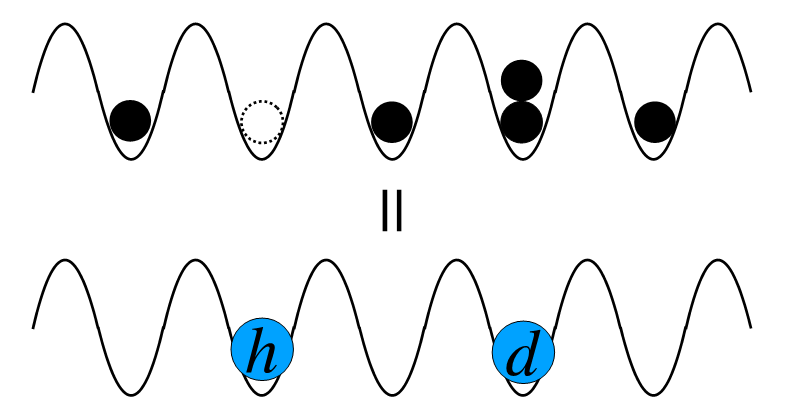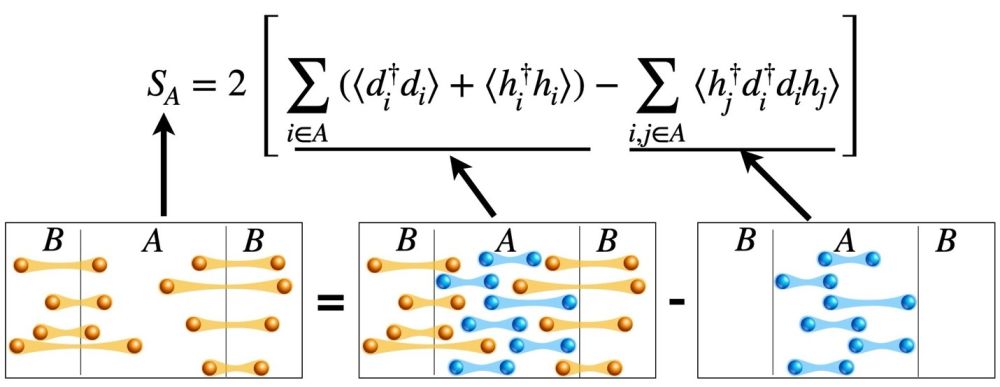2023.12.13
News
Unraveling the generation and propagation of quantum entanglement in strongly correlated bosons trapped in an optical lattice - Toward experimental validation -
Abstract
The research group led by Chuo University’s Associate Professor, Shunji Tsuchiya, and the graduate school student, Shion Yamashika, theoretically unraveled the behavior of quantum entanglement in the system of bosons*1 in an optical lattice, a periodic potential created by interference of lasers.
Quantum entanglement indicates special correlations between particles. Recently, there has been a lot of research into understanding strongly correlated many-body systems such as electrons in a solid, from the aspect of quantum entanglement. However, there is still much that remains to be elucidated because of the theoretical and experimental difficulties in studying quantum entanglement of strongly correlated many-body systems. The system of strongly correlated bosons trapped in an optical lattice has attracted much attention as one of ideal platforms to study quantum entanglement in strongly correlated systems because the entanglement entropy, one of the measure of quantum entanglement, can be experimentally measured in this system.
In this research, they studied theoretically the mechanisms of creation and propagation of quantum entanglement in a strongly correlated bosons trapped in an optical lattice. In this system, sites with one more boson than the average and those with one less boson than the average behave as particles called doublons and holons, respectively (figure 1).
In this research, they calculated the correlation function between doublons and holons by using the wave function*2 for doublons and holons. Then they derived a formula of entanglement entropy*3 investigate quantum entanglement quantitatively. By using this formula, entanglement entropy can be calculated even for a small system or a short time scale which was impossible before. This fact will be a great advantage in verifying this formula in experiments where the system size and time scale are limited.
In addition, it was revealed from the derived formula that quantum entanglement in this system is caused by the creation of entangled doublon-holon pairs, and spreads throughout the system by the propagation of the pairs.
This study is the world's first to theoretically reveal the dynamics of quantum entanglement in the system of strongly correlated bosons. The findings will make a tremendous contribution to unraveling the behavior of quantum entanglement in other strongly correlated systems such as high-temperature superconductors. It is expected that this finding will open the door to further understanding the quantum entanglement in strongly correlated systems and lead to the development of quantum computer which enables much faster computation than the conventional one using quantum entanglement.
In addition, quantum entanglement due to entangled pairs is also known as the origin of the "Hawking radiation", a heat emission by a black hole due to quantum effects. Therefore, their finding in this study is also expected to be a key to understanding the Hawking radiation microscopically.
The research accomplishment was published online in the American Physical Journal, Physical Review Research, on November 1st, 2023 (Eastern Standard Time).

Figure 1. Schematic drawing of the system of bosons in an optical lattice. The wavy lines and black dots represent the optical lattice and bosons, respectively. The blue circles with d and h represent doublons and holons, respectively.
【Researchers】
Shunji Tsuchiya, Associate Professor, Faculty of Science and Engineering of Chuo University (Department of Physics)
Shion Yamashika, Graduate School of Science and Engineering of Chuo University (Physics Course)
【Article Information】
Journal: Physical Review Research
Title : Evolution of entanglement entropy in strongly correlated bosons in an optical lattice
Authors: Shion Yamashika1, Daichi Kagamihara2, Ryosuke Yoshii3, and Shunji Tsuchiya1
Affiliation:1Department of Physics, Chuo University
2Department of Physics, Kindai University
3Center of Liberal Arts and Sciences, Sanyo-Onoda City University
DOI: 10.1103/PhysRevResearch.5.043102
Research Content
1. Background
Quantum mechanics is one of the foundations of modern physics, possessing counterintuitive characteristics. Quantum entanglement, which represents non-local correlations between particles, is one example of such a quantum phenomenon and has attracted much attention in the study of modern physics. In fact, the 2022 Nobel Prize was awarded to the researchers studying quantum entanglement. Furthermore, a quantum computer, which has recently been extensively studied, is expected to be capable of calculating much faster than the conventional computer by making use of quantum entanglement. On the other hand, systems consisting of many strongly interacting particles such as electrons in solids are called strongly correlated systems because of the strong interaction between the particles and are known to exhibit novel properties including high-temperature superconductivity. The understanding of strongly correlated systems, including the origin of high-temperature superconductivity, has not yet progressed. In recent years, there have been many attempts to understand the properties of strongly correlated systems from the viewpoint of quantum entanglement. However, it is, in general, difficult to investigate quantum entanglement in strongly correlated systems both in theory and experiment, and, therefore, there are still many unresolved questions.
2. Research Content and Accomplishment
In this study, to elucidate quantum entanglement in strongly correlated systems, the research group focused on strongly correlated bosons trapped in an optical lattice and theoretically studied the mechanisms of creation and propagation of quantum entanglement in this system. The optical lattice is a periodic trap created by interference of lasers. This system has the great advantage that the interaction between bosons can be modulated by tuning the laser intensity, and the entanglement entropy, a measure of quantum entanglement, can be measured experimentally.
In the system of strongly correlated bosons, the state with one more boson than the others and the state with one boson missing behave as particles referred to as doublon and holon, respectively (Figure 1). In order to investigate quantum entanglement quantitatively, the authors calculated the correlation function between doublon and holon using the wave function for doublons and holons, and derived the formula for entanglement entropy. Surprisingly, this formula allows us to accurately calculate the entanglement entropy even for small systems and short time scales, which could not be analytically calculated before. This is a great advantage in verifying our results in actual experiments where the system size and time scale are limited.
Furthermore, in this study, they revealed the physical picture of the behavior of quantum entanglement in this system from the derived formula of entanglement entropy. They devided the system into two areas A and B and studied the entanglement between them (figure 2). They found out from the formula that, the entanglement entropy, which expresses the amount of quantum entanglement between regions A and B, is proportional to the number of entangled pairs consisting of doublons and holons that straddle the boundary between regions A and B. Furthermore, from the analytical expression for the entanglement entropy derived using this formula, it was found that the entangled pairs of doublons and holons are generated everywhere in this system and spread in time. As a result, the number of the entangled pairs that straddle the boundary increases in proportion to time, and due to this, the entanglement entropy increases in proportion to time as well. Then, when the size of the pairs became as same as the size of area A, they found that entanglement entropy converges to a constant value (figure 2). On the other hand, besides the spreading pairs, some pairs repeat creation and annihilation inside a small area, and it is revealed that this induces oscillation of entanglement entropy in a short time scale.

Figure 2: Formula for entanglement entropy. The first term in the right-hand side represents the total number of entangled pair that straddle the boundary of the area A and B, and that inside A. The second term represents the number of pairs inside the area A.
3. Future Development
As mentioned above, it is possible to measure the entanglement entropy in the system of strongly correlated bosons trapped in an optical lattice, so the formula and the physical interpretation of entanglement entropy which they found in this study can be validated in experiments.
This study is the first case in the world to theoretically reveal the dynamics of quantum entanglement in a strongly correlated system and it is possible that the accomplishment will contribute to making substantial progress in the understanding of strongly correlated quantum entanglement. The further understanding of quantum entanglement in strongly correlated systems may pave the way to the development of quantum computer which has far more high-speed calculation ability than the conventional one. In addition, quantum entanglement of particle pairs formed around a black hole can be considered to engage in "Hawking radiation", a phenomenon of heat emission by a black hole due to quantum effects, the finding from this study is also expected to reveal the principle of Hawking radiation.
●The research was conducted with the support of the following research funds (Main Administration, Funding Agency, etc.)
Grant-in-Aid for JSPS Fellow (Japan Society for the Promotion of Science) JP22J22306, Grant-in-Aid for Scientific Research C (Ministry of Education, Culture, Sports, Science and Technology) 19K03691
Grant-in-Aid for Scientific Research C 19K14616, Grant-in-Aid for Scientific Research B 20H0838
【Glossary】
*1 Boson
A collective term of particles which possess spin angular momentum of integer multiple. It can be characterized as multiple particles that may have been in the same status.
*2 wave functions
Functions that describe the state of quantum mechanical particles. It is a complex number in general and its squared absolute value represents the probability of finding a particle.
*3 entanglement entropy
The amount that represents how much particles or two subsystems are entangled. Entanglement entropy is named since it is defined as a formula similar to entropy, however, it is a physical quantity different from entropy.
【Contact Information】
Associate Professor (Department of Physics), Faculty of Science and Engineering, Chuo University
E-mail: tsuchiya★phys.chuo-u.ac.jp
Please replace ★ with @ when sending a mail.
Research Support Office, Chuo University
E-mail: kkouhou-grp★g.chuo-u.ac.jp
Please replace ★ with @ when sending a mail.
